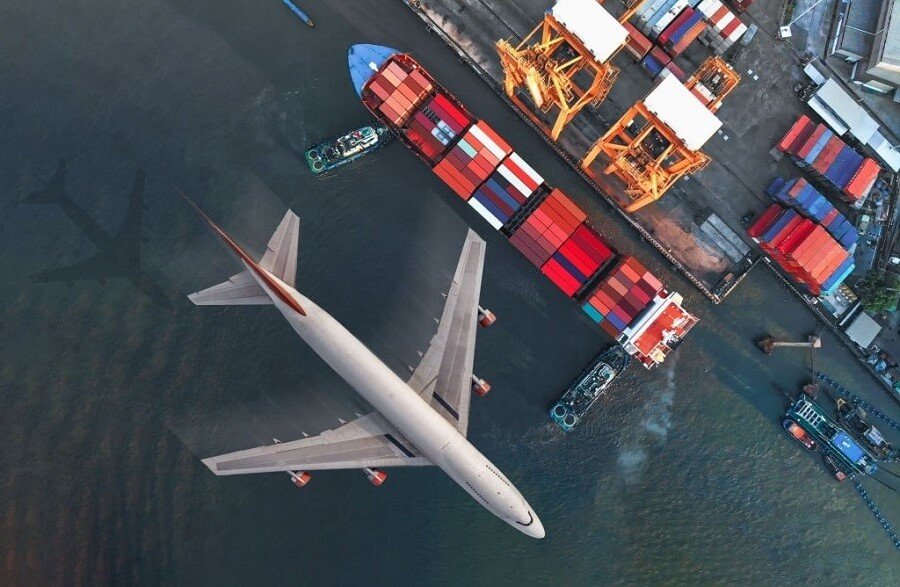With limited physical infrastructure, new digital infrastructure and processes are needed to increase throughput, reduce friction, and improve transparency and coordination. The evident three pillars to the emerging movement of goods ecosystem: connected community, holistic decision-making and intelligent automation. Forward thinkers are beginning to see the opportunities to differentiate across all three of these dimensions.
End-to-end transparency through connected community
Addressing fragmentation through connected communities is among the greatest challenges and opportunities facing transportation and logistics. But the horizontal partnerships forming around ports serve as a strong example of what’s possible.
Integrated data platforms, such as those found in Hamburg and Rotterdam, exchange critical port information—including ship arrival and departure times—to participating ports, shipping lines, and marine terminals coordinating drayage. Powered by cloud, integrated platforms handle large transaction volume between disparate applications, and enable ports to orchestrate the network with real-time data exchange, optimising ship course and speed, vessel berthing, ship offloading, and response to schedule changes. The collaboration has already led to a 20 per cent reduction in dwell times for ships that can cost up to US$80,000 per hour to operate.
The significance of this platform is a mindset shift as well as a technological one. Ecosystem participants, some direct competitors, are collaborating to digitise and connect. And in the case of new smart ports, all stakeholders have been given an active seat at the table during planning and development, helping to create open platforms with mutual benefit.
Accompanying integrated platforms created by the physical movers, pure technology players—from startups to projects backed by industry incumbents—are investing billions to mature the world of digital freight. While digital platforms that match cargo to available capacity in real time are certainly not new, they are proliferating in number and, more importantly, expanding beyond their historical concentration in spot-trucking to different points of the value chain, from air and ocean to rail and B2B freight.
Some platforms are even taking digital freight end-to-end. Cainiao, China’s leading digital logistics business connecting e-retailers with end-to-end logistics, is achieving enormous scale. The brand has already amassed more than 90 trucking and air carriers, six digital fulfilment hubs, 266 IoT-connected warehouses, and a variety of last-mile networks, including self-pickup locations, smart lockers, and express couriers. Their ability to see across the growing network, and marry it all with AI applications to match shippers to the lowest-cost and fastest routes is driving a significant competitive advantage. Cainiao is already processing an average of 42 million packages per day, with ambitions to deliver an online order anywhere in the world in under three days.
In theory, digital freight seems like a quick fix for a fragmented industry. But it’s not so simple (see sidebar, “The interoperability hurdle”). The proliferation of new platforms will not lead to freight markets that follow the laws of perfect competition overnight, if ever. Platforms of Cainiao’s size are rare. Most struggle to grow the partnerships needed to achieve scale—and, in a way, create fragmentation themselves as vertical stacks of integrated products. But similar stories have played out in other industries. History suggests that waves of consolidation and evolution in digital freight might be inevitable. In the early days of online travel, for example, hundreds of online travel agencies—most regional, with limited inventory—connected travelers to the world’s hotels and airlines. After decades of consolidation, only a handful of global players command significant market share, and their content is further aggregated by a handful of leading travel metasearch platforms.
But what are the implications? And where are the opportunities? For regional parcel carriers and logistics providers, the improved, real-time visibility into available cargo and tech-enabled coordination could be what’s needed to materially improve utilisation. The ability to leverage the assets of other carriers through shared models could help expand coverage and monetize or acquire additional capacity, enabling fleets that flex with demand or create new revenue streams. A single 26-foot truck traveling 100 miles per day can generate up to US$3,300 per month.
For retailers, the additional freight services and crowdsourced assets offer new opportunities to meet growing last-mile and peak season demand. As comfort with sharing models and crowdsourcing rises, retailers will have fresh options for moving goods between stores or middle mile.
Agility through holistic, data-driven decision-making
Many of today’s global movers are already data-driven. For example, the quantitative rigor that a logistics provider might use to design a custom supply chain for a global retailer is quite sophisticated—as are the range of increasingly integrated transactional systems, enterprise resource planning systems (ERPs), transportation management systems (TMS), warehouse management solutions (WMS), and software tools used to manage those operations.
But where today’s global movers need to focus is compressing the time between data collection and meaningful action. Global supply chains can be planned with immense precision, but dealing with unpredictable environments and rising consumer demands requires the agility to react to changing network conditions with dynamic decisions and, perhaps in the not-too-distant future, to tailor microsupply chains for each product and customer.
Early adopters are not only finding success from a mix of new data sources from connected assets, cargo, and warehouses—in some cases, they are harmonising these new data streams with transportation management, inventory management, and other supply chain functions. These capabilities serve as early signals that traditional, linear supply chains are just beginning to collapse into more dynamic digital supply networks, where once-isolated data sources—such as operations data, connected assets and cargo, and historic data—begin centering on a digital core that provides real-time decision support.
The transition is starting. Ocean shipping giant Maersk already commands a fleet of 270,000 IoT-enabled cold containers, transmitting data on temperature, location, and refrigeration power supply to the cloud, helping automate oversight, exception alerts, and quality control processes at ports. In transportation, DHL recently announced its goal to have 10,000 IoT-connected trucks operating in India by 2028, estimated to provide over 95 per cent reliability for inventory and temperature tracking for perishable goods in the region.
In retail, sensor data is being aimed at significant pain points, such as supply chain visibility and inventory management. Keeping hundreds of distribution and retail locations stocked with the right levels of inventory while simultaneously creating a virtually endless aisle to online customers is the complexity behind an estimated US$2.1 trillion in overstocks and out-of-stocks across the US retail industry.
As companies become more involved in digital transformation and build their capabilities, they are likelier to realize its benefits—and keep investing to further grow their expertise. This snowball effect of investment and success is exemplified by the long-term rollout of UPS’s dynamic routing system Orion. Orion’s first generation was far from real-time, but its yield of US$100 million in annual savings spurred investment for second-generation upgrades, bringing the system into real-time through delivery information acquisition devices that communicate optimized routes to drivers while on the road. Planned upgrades may incorporate a driver’s remaining pickup and delivery requests, as well as external data sources such as traffic and weather.
Instrumentation only looks to accelerate. According to a recent Deloitte executive study, supply chain was rated among the biggest opportunities for IoT technology. The growing interest, combined with improving interoperability, latency, and protocols for 5G-to-5G device communication, and falling sensor costs, will continue to make piloting and scaling new solutions cheaper and faster. With time, data-driven decision-making will likely get more sophisticated, expanding connectivity with smart city sensors, predictive traffic flow models, and other data sources.
Automating the network
While visions of self-driving robo-taxis in cities grab much of the limelight, autonomy and robotics bring similar implications for the future of the movement of goods. Evidence of maturing automation can now be found at every step in the chain, and while still some ways away, the foundations of a global, touchless supply chain are actively forming.
Autonomous cargo ships are in development, while some ports already feature an entirely robotic ship offloading process. Nearly 50 companies are progressing on AV technology, and many, such as Embark, Waymo, and Tesla, are focussing efforts on trucking. Warehouse robotics that lift, move, and sort are widely in use and gaining dexterity. Ocado, an online-only UK supermarket, can process 3.5 million items per week in highly automated warehouses working around the clock. And last-mile automation, from drones to droids, is transitioning from concept to pilots. Flytrex, an on-demand drone delivery startup, delivers packages in Iceland, while some grocers deliver fresh produce in Arizona with autonomous delivery vehicles.
These concepts could be the early foundations of a touchless supply chain. But capturing the concept’s full potential will likely require rethinking entire logistics systems to take full advantage of a constant flow, including an evolution away from the fixed “collect in the evening and deliver during the morning” approach toward a fluid system of continuous movement and supply—as well as key transactions configured entirely around human labor. Some processes, such as truck-loading at warehouses, for example, can be reimagined in their entirety. By combining emerging autonomous warehouse technology with autonomous self-driving systems for long-haul transport, new types of vehicles can begin hauling trips as soon as they receive cargo. These new freight transport vehicles could range in size—and seamlessly pass through automated warehouses and distribution centres. There will likely be a blurring of lines between the movement of goods and people. The digital management infrastructure that powers new mobility ecosystems designed for urban transport may be vital to, for instance, logistics providers and retailers in the last-mile. Companies such as AEV Robotics are already designing modular vehicle systems for cities that allow businesses, city planners, and fleet managers to configure autonomous solutions for a multitude of applications. A variety of functional pods can be placed over autonomous, electric chassis, from on-demand ride-hailing to medical services, industrial applications, same-day delivery, and fresh food retail.







